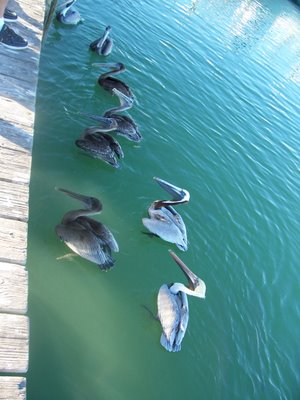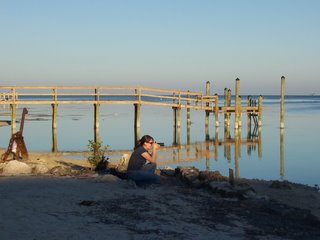Bermuda, Bahama, come on pretty mama to Key Largo...

...and Islamorada! If you can believe it, we drove in one day from South Beach (with its own unique brand of wildlife ;-) to the Everglades, and then, on the way back from the Everglades, we spotted a sign. It said, "Key Largo - 25 miles," or something to that effect. We thought, "What the heck! Let's give it a go!"
Neither one of us had ever been to the Keys, so we didn't quite know what to expect. First of all, it was difficult to tell when we crossed into Key Largo from the mainland. I expected some sort of huge bridge or demarcation, but the bridge was rather small. Key Largo itself looked much like the mainland of small town Florida. We'll have to visit John Pennekamp Coral Reef State Park next time we're there. It's a State Park entirely under water to protect the fragile reef system. Since it was getting late though, we decided to venture farther on to Islamorada, the "sport fishing capital" of the Keys.
Once we hit Islamorada, things started to change. The second key is much smaller than Key Largo, so we could see a lot more of the ocean on all sides. The smell of sea air and the constant breezes were invigorating. We headed first to Robbie's Pier; a recommendation from our Frommer's Guide upon which we rely heavily. ;-) The pier was very hard to see, as it was surrounded by weather beaten wooden buildings scattered around a small gravel and dirt parking lot. The small building that led to the pier housed food to feed the tarpon along with hundreds of photos of beaming fishermen holding up massive fish.
We paid a small fee to walk out onto the surprisingly small pier where about 15 people were pointing and shrieking as the huge fish battled for any morsel of food dropped their way. To give you an idea, tarpon can weigh up to 200lbs and grow to approximately 4 feet in length. They are massive! It was almost scary to see at least 50 of these twisting silvery fish swarming the water. When people tried to hand feed them, they would even grab fingers! We didn't feed them, but enjoyed the show. Something I enjoyed seeing even more were the brown pelicans. There were about 20 of them waiting for any food the fish happened to miss. The really interesting thing was that we were able to get close enough to tell from the different feather colorations which ones were adults, chick breeding adult, juveniles etc. Many birds change feather coloration for breeding purposes, but brown pelicans change from juvenile, to subadult, to breeding, to non breeding, to chick feeding. The picture below illustrates it.

From top to bottom, the first bird, almost out of frame, is a subadult. The next 4 are immature birds, then a chick feeding adult with the extensive brown framing on its neck and another immature. And the farthest one down in the frame is a non-breeding adult.
We decided to turn around after seeing Robbie's Pier since the keys are a 150 mile long chain of islands connected by a slow, mostly 2 lane Route 1. It would have taken too long. Someday we'll drive the 6 and a half hours from Orlando to Key West. I never imagined it was that far.
On this whole trip, there were a few birds I was really keeping my eye out for. Two of them were different color morphs of the Great Blue Heron. One is white and one has a mix of blue and white coloration and is called "Wurdemann's" heron. Both of these are found mainly in south Florida and in the Keys. It can be difficult from a distance to tell the great "white" heron from the great egret, which are both white and in the same genus (Ardea). However, the heron's head is shaped differently, it's much larger, and the most obvious sign is its light colored legs. The egret's are black.
I'm describing all this because on the way to Robbie's Pier, I thought I might have caught a glimpse of a large white bird out in the water. On the way back, I very
 much wanted to check it out, as I thought it could possibly be the white morph I wanted to see so badly! We pulled into a little oceanside restaurant, got out the binoculars, and sure enough, it was the lighter legged white morph great blue!! I took tons of photos, but even with my large camera, it was too far off, and my dubious photography skills didn't make it easier.
much wanted to check it out, as I thought it could possibly be the white morph I wanted to see so badly! We pulled into a little oceanside restaurant, got out the binoculars, and sure enough, it was the lighter legged white morph great blue!! I took tons of photos, but even with my large camera, it was too far off, and my dubious photography skills didn't make it easier.We played around a little more after that, but it was getting late, and we had to head back to our hotel in South Beach. I saw a few terns and gulls from a distance before I conked out and let Ron take control of the directions. Next trip to the Keys... it's Key West here we come!

0 Comments:
Post a Comment
<< Home